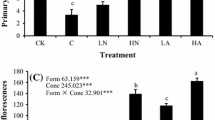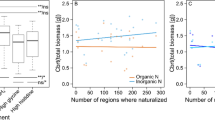Abstract
Although nitrogen has historically limited terrestrial plant productivity in the northern hemisphere, accelerated industrial activity is changing the availability of N, with consequences for ecosystem properties including altered susceptibility to biological invasion. Alliaria petiolata (Bieb.) Cavara & Grande is an increasingly problematic invader in forests of eastern North America. Population growth rate of this species is especially high in N-rich habitats, and it produces a variety of N-based compounds that have been shown to interfere with the growth and reproduction of native plants. To investigate how increases and shifts in forms of N will impact A. petiolata, seedlings were transplanted to the greenhouse from the field and grown in sand culture. We applied three concentrations of N (0.25, 1 and 2 mM) using five different ratios of NH4 + and NO3 − (100/0, 75/25, 50/50, 25/75, 0/100) in a crossed design to yield fifteen different treatments. Plants were measured throughout the growing season and a final harvest yielded measures of biomass and tissue quality. Plant growth increased significantly in response to increased concentration of total N. These increases were similar for all combinations of N. This flexibility in uptake ability may facilitate the invasion of this species, not only by increasing the range of habitats A. petiolata can occupy but also by enhancing N uptake that can lead to the production of secondary compounds disrupting other species’ belowground mutualisms. We suggest that this species’ ability to respond rapidly to changes in N availability, regardless of its form, may modify competitive interactions with natives and intensify its negative impacts.



Similar content being viewed by others
References
Abbès C, Parent L, Karam A, Isfan D (1995) Effect of NH4 +:NO3 − ratios on growth and nitrogen uptake by onions. Plant Soil 171:289–296
Bloom AJ, Jackson LE, Smart DR (1993) Root growth as a function of ammonium and nitrate in the root zone. Plant Cell Environ 16:199–206
Cavers PB, Heagy MI, Kokron RF (1979) The biology of Canadian weeds 35 Alliaria petiolata M Bieb Cavara and Grande. Can J Plant Sci 59:217–229
Cipollini D, Gruner B (2007) Cyanide in the chemical arsenal of garlic mustard Alliaria petiolata. J Chem Ecol 33:85–94
Crawford NM, Glass ADM (1998) Molecular and physiological aspects of nitrate uptake in plants. Trends Plant Sci 3:389–395
de Graaf MCC, Bobbink R, Roelofs JGM, Verbeek PJM (1998) Differential effects of ammonium and nitrate on three heathland species. Plant Ecol 135:185–196
Dhillion SS, Anderson RC (1999) Growth and photosynthetic response of first-year garlic mustard Alliaria petiolata to varied irradiance. J Torrey Bot Soc 126:9–14
Ehrenfeld J (2003) Effects of exotic plant invasions on soil nutrient cycling processes. Ecosystems 6:503–523
Ehrenfeld J (2006) A potential novel source of information for screening and monitoring the impact of exotic plants on ecosystems. Biol Invasions 87:1511–1521
Fichtner K, Schulze ED (1992) The effect of nitrogen nutrition on growth and biomass partitioning of annual plants originating from habitats of different nitrogen availability. Oecologia 92:236–241
Funk JL, Vitousek PM (2007) Resource-use efficiency and plant invasion in low-resource systems. Nature 446:1079–1081
Glass ADM, Glass Anthony DM, Britto DT, Kaiser BN, Kinghorn JR, Kronzucker HJ, Kumar A, Okamoto M, Rawat S, Siddiqi MY, Unkles SE, Vidmar JJ (2002) The regulation of nitrate and ammonium transport systems in plants. J Exp Bot 53:855–864
Govindarajulu M, Pfeffer PE, Jin H, Douds DD, Allen JW, Bücking H, Lammers PJ, Shachar-Hill Y (2005) Nitrogen transfer in the arbuscular mycorrhizal symbiosis. Nature 435:819–823
Gross KL, Mittelbach GG, Reynolds HL (2005) Grassland invasibility and diversity: responses to nutrients, seed input, and disturbance. Ecology 86:476–486
Gurevitch J, Scheiner S, Fox G (2002) The ecology of plants. Sinauer Associates Incorporated, Sunderland, 518 pp
Hoel BO, Solhaug KA (1998) Effect of irradiance on chlorophyll estimation with the Minolta SPAD-502 Leaf Chlorophyll Meter. Ann Bot London 82:389–392
Hoffmann A, Milde S, Desel C, Hümpel A, Kaiser H, Hammes E, Piippo M, Soitamo A, Aro E, Gerendás J, Sattelmacher B, Hansen U (2007) N form-dependent growth retardation of Arabidopsis thaliana seedlings as revealed from physiological and microarray studies. J Plant Nutr Soil Sci 170:87–97
Imsande J, Edwards G (1988) Decreased rates of nitrate uptake during pod fill by cowpea green gram and soybean. Agron J 80:789–793
Imsande J, Touraine B (1994) N demand and the regulation of nitrate uptake. Plant Physiol 105:3–7
Markwell J, Osterman JC, Mitchell JL (1995) Calibration of the Minolta SPAD-502 leaf chlorophyll meter. Photosynth Res 46:467–472
Marschner H (2002) Mineral nutrition of higher plants. Academic Press, London, 889 pp
Marschner H, Haussling M, Eckhard G (1991) Ammonium and nitrate uptake rates and rhizosphere pH in non-mycorrhizal roots of Norway spruce [Picea abies L Karst]. Trees Struct Funct 5:14–21
Matson P, Lohse KA, Hall SJ (2002) The globalization of nitrogen deposition: consequences for terrestrial ecosystems. Ambio 322:113–119
Meekins JF, McCarthy BC (2000) Responses of the biennial forest herb Alliaria petiolata to variation in population density, nutrient addition and light availability. J Ecol 88:447–463
Miller A, Bowman W (2002) Variation in nitrogen-15 natural abundance and nitrogen uptake traits among co-occurring alpine species, do species partition by nitrogen form? Oecologia 130:609–616
Nuzzo V (2000) Element stewardship abstract for Alliaria petiolata, Alliaria officinalis Garlic mustard. The Nature Conservancy, Arlington, 19 p
Olsson MO, Falkengren-Grerup U (2000) Potential nitrification as an indicator of preferential uptake of ammonium or nitrate by plants in an oak woodland understorey. Ann Bot 85:299–305
Orsel M, Filleur S, Fraisier V, Daniel-Vedele F (2002) Nitrate transport in plants: which gene and which control? J Exp Bot 53:825–833
Piccini D, Azcon AR (1987) Effect of phosphate-solubilizing bacteria and vesicular-arbuscular mycorrhzial fungi on the utilization of Bayovar rock phosphate by alfalfa plants using a sand-vermiculite medium. Plant Soil 101:45–50
Pickart AJ, Miller LM, Duebendorfer TE (1998) Yellow bush lupine invasion in Northern California coastal dunes I. Ecological impacts and manual restoration techniques. Restor Ecol 6:59–68
Rickey MA, Anderson RC (2004) Effects of nitrogen addition on the invasive grass Phragmites australis and a native competitor Spartina pectinata. J Appl Ecol 41:888–896
Roberts H, Boddrell J (1983) Seed survival and periodicity of seedling emergence in eight species of Cruciferae. Ann Appl Biol 103:301–309
Shimoji H, Tokuda G, Tanaka Y, Moshiri B, Yamasaki H (2006) A simple method for two-dimensional color analyses of plant leaves. Russ J Plant Physiol 53:126–133
Spencer DF, Sher A, Thornby D, Ksander GG (2007) Non-destructive assessment of Arundo donax poaceae leaf quality. J Freshw Ecol 22:277–285
Stinson KA, Campbell SA, Powell JR, Wolfe BE, Callaway RM, Thelen GC, Hallett SG, Prati D, Klironomos JN (2006) Invasive plant suppresses the growth of native tree seedlings by disrupting belowground mutualisms. PLoS Biol 4:e140
Tilman DA (1982) Resource competition and community structure. Princeton University Press, Princeton, 296 pp
von Wirén N, Gazzarrini S, Gojon A, Frommer WB (2000) The molecular physiology of ammonim uptake and retrieval. Curr Opin Plant Biol 3:254–261
Zhang F-C, Kang S-Z, Li F-S, Zhang J-H (2007) Growth and major nutrient concentrations in Brassica campestris supplied with different NH4 +/NO3 − ratios. J Integr Plant Biol 49:455–462
Acknowledgments
The authors thank Heather Throop for advice on our drip system and nutrient solutions. Further thanks to Sheena Gayomba, Crystal Thompson, Josh Crossley and Danielle Cheong for helping with midterm measurements and the final harvest. This work was supported by the Merck-American Association for the Advancement of Science Undergraduate Science Research Program at Rider University and National Science Foundation Research at Undergraduate Institutions grant #DEB 0344218 to LAH.
Author information
Authors and Affiliations
Corresponding author
Rights and permissions
About this article
Cite this article
Hewins, D.B., Hyatt, L.A. Flexible N uptake and assimilation mechanisms may assist biological invasion by Alliaria petiolata . Biol Invasions 12, 2639–2647 (2010). https://doi.org/10.1007/s10530-009-9671-5
Received:
Accepted:
Published:
Issue Date:
DOI: https://doi.org/10.1007/s10530-009-9671-5




